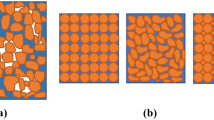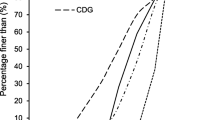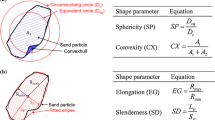Abstract
Direct methods of estimating particle shape become lengthy if a truly representative sample of a sand is to be examined and are therefore unsuitable for routine use. Thus indirect methods have been developed in which a bulk property of the material, which is strongly influenced by grain shape, is measured in a standard test.
The purpose of the work reported in this paper was to seek a correlation between shape parameters obtained by direct examation of individual grains and those derived from simple bulk tests. This work has resulted in a quick reliable method of estimating grain shapes of natural silica sands from a flow rate test.
Résumé
La forme et les propriétés de surface des particules ont une influence importante à la fois sur le comportement des agrégats libres et sur les résistances à l'écrasement et à la flexion du béton et des mélanges bitumineux. En général l'effet des agrégats fins est plus marqué que celui des gros agrégats, comme il a été démontré, par exemple par Herrin et Goets [4] et Lees [9] pour les mélanges bitumineux. La dureté des agrégats fins effecte aussi la glissance des chaussées en béton, et Weller et maynard [21], en incorporant aux mélanges un sable naturel à haute teneur en silice, ont obtenu une plus forte réduction de la glissance que celle qui résulte de l'emploi de sables de dureté plutôt faible ou de matériaux finement broyés, tels que la dolérite, le calcaire ou du grès grossier.
Les méthodes les plus directes d'estimation de la forme des particules se sont appuyées sur les définitions originales de Wadell [19, 20] de la sphéricité et de l'arrondi, mais leur développement en paramètres d'application appropriés ne s'est pas fait sans quelque imprécision. En particulier, si l'on se sert d'abaques de comparaison, l'évaluation de la forme dépend largement d'une interprétation personnelle. Même ces méthodes prennent du temps si l'on a à examiner un échantillon de sable réellement représentatif et par conséquent ne conviennent pas aux examens de routine.
C'est la raison pour laquelle on a mis au point des méthodes indirectes où une caractéristique globale du matériau, qui est fortement influencée par la forme des grains, est mesurée par un essai normalisé, et l'on en dérive ensuite un paramètre de forme empirique.
Le but de cette étude était de rechercher une corrélation entre les paramètres de forme obtenus par examen direct de grains individuels et ceux fournis par les simples essais globaux. On dispose ainsi d'une méthode rapide et sûre d'estimation de la forme des grains des sables siliceux naturels par l'emploi de l'essai d'écoulement.
Similar content being viewed by others
Abbreviations
- A:
-
angularity factor from flow rate test
- A a :
-
angularity factor from loose bulk density test
- a :
-
long diameter of particle
- b :
-
intermediate diameter of particle
- b B :
-
solid volume per unit volume
- c :
-
short diameter of particle
- d :
-
average particle size
- F:
-
shape factor
- G b :
-
specific gravity of ballotini
- G s :
-
specific gravity of sand
- M:
-
slopes of flow time/sphericity plots
- N:
-
slopes of flow time/roundness plots
- n :
-
porosity
- q :
-
flow time
- q b :
-
flow time for ballotini
- q s :
-
flow time for sand
- ρ:
-
roundness
- ρ′:
-
adjusted roundness
- Ψ:
-
sphericity
- Ψ0 :
-
inscribed circle sphericity
- Ψ′0 :
-
adjusted inscribed circle sphericity
- Ψ0p :
-
sphericity (working)
- Ψ p :
-
projection sphericity
References
Aschenbrenner B.C.—A New Method of Expressing Particle Sphericity, J. Sed. Pet., 26, 1956, p. 15.
Beal M.A. andShepard F.C.—A Use of Roundness to Determine Depositional Environments. J. Sed. Pet. Vol. 26, 1956, No. 1, pp. 49–60.
Dickin E.A.—The Influence of Grain Shape and Size on the Shear Strength Components of Quartz Sands. Ph. D. Thesis, University of Liverpool, 1971.
Herrin M. andGoetz W.H.—Effect of Aggregate Shape on Stability of Bituminous Mixes. Highway Research Board Proceedings, 1954, pp. 293–306.
Hughes B.P.—Mix Design for High Quality Concrete, using Crushed Rock Aggregates, Journal of the British Granite and Whinstone Federation, Vol. 4, 1964, No. 1, pp. 33–53.
Hughes B.P. andBahramian B.—A Laboratory Test for Determining the Angularity of Aggregate. Magazine of Concrete Research, Vol. 18, 1966, No. 56, pp. 147–152.
Krumbien W.C.—Measurement and Geological Significance of Shape and Roundness of Sedimentary Particles. J. Sed. Pet., 11, 1941, p. 64.
Lees G.—A New Method for Determining the Angularity of Particles. Sedimentology, 3, 1964 a, pp. 2–21.
Lees G.—The Measurement of Particle Shape and its Influence in Engineering Materials. British Granite and Whinstone Federation Journal, Vol. 4, 1964 b, No. 2, pp. 17–38.
Loudon A.G.—A Laboratory Study of the Permeability of Sand. Geotechnique 3, 1952, No. 4, pp. 165–183.
Pettijohn F.J.—Sedimentary Rocks. Harper, New York, 1949.
Powers M.C.—A New Roundness Scale for Sedimentary Particles. J. Sed. Pet., 23, 1953, No. 2, p. 117.
Rex H.M. andPeck R.A.—A Laboratory Test to Evaluate the Shape and Surface Texture of Fine Aggregate Particles. Journal of Public Roads, Vol. 29, 1956, No. 5, pp. 118–120.
Riley N.A.,Projection Sphericity, J. Sed. Pet., 11, 1941, No. 2, p. 94.
Rittenhouse G.—A Visual Method of Estimating Two-Dimensional Sphericity. J. Sed. Pet., 13, 1943, No. 2, p. 79.
Robertson R.H.S. andEmödi B.S.—Rugosity of Granular Solids. Nature, Vol. 152, 1943, pp. 539–540.
Shepard F.P. andYoung R.—Distinguishing Between Beach and Dune Sands. J. Sed. Pet., 31, 1961, No. 2, p. 196.
Shergold F.A.—The Percentage Voids in Compacted Gravel as a Measure of its Angularity. Magazine of Concrete Research, Vol. 5, 1953, No. 13, pp. 3–10.
Wadell H.—Volume, Shape and Roundness of Rock Particles, J. Geol., 1932, p. 443.
Wadell H.—Volume, Shape and Roundness of Quartz Particles. J. Geol., 1935, p. 250.
Weller D.E. andMaynard D.P.—The Influence of Materials and Mix Design on the Skid Resistance Value and Texture Depth of Concrete. R. R. L. Report, LR 334, 1970.
Zingg T.—Beitrag zur Schotteranalyse. Schweiz Mineral Petrog. Mitt. 15, 1935, pp. 39–140.
Author information
Authors and Affiliations
Rights and permissions
About this article
Cite this article
King, G.J.W., Dickin, E.A. The evaluation of grain shapes in silica sands from a simple flow test. Mat. Constr. 5, 85–92 (1972). https://doi.org/10.1007/BF02478437
Issue Date:
DOI: https://doi.org/10.1007/BF02478437




